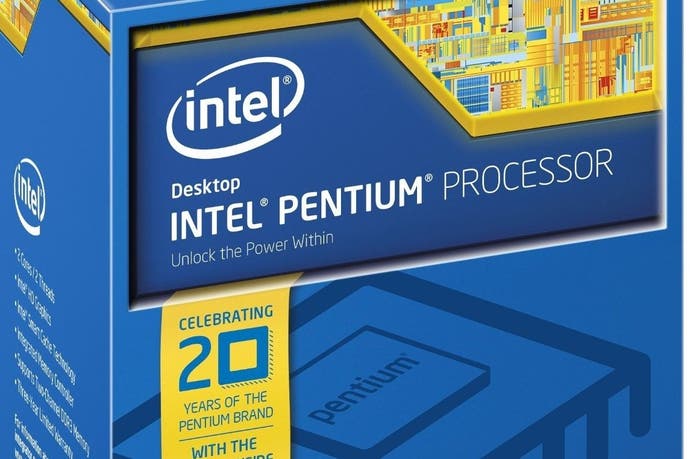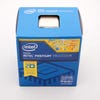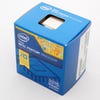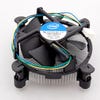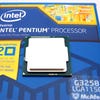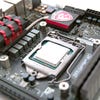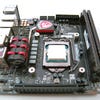Pentium G3258 Anniversary Edition review
£45 for a CPU that clocks up to 4.5GHz - do you really need that i7?
Overclocking: the arcane art of brute-forcing more performance out of your components through a combination of raw voltage and increased clock-speeds. Back in the day, virtually any CPU could be overclocked, resulting in some colossal performance gains and a gargantuan increase in the all-important "bang for your buck" on select processors. Those days are mostly gone now, with Intel locking down multipliers and base-clocks for all but a small number of enthusiast-centric processors, but to celebrate those glory days, the firm has released the stealthily titled Pentium G3258 - a 20th anniversary special edition.
On the face of it, the processor is nothing special. Imagine a 3.2GHz Core i3 based on the Haswell architecture with less cache and no Hyper Threading - that's effectively what the G3258 is. It's priced to match its lacklustre feature-set, coming in at under £45. However, beyond the obvious mediocrity, it is very special in one respect: the multiplier is unlocked, meaning you can overclock the hell out of it. Just how fast you can make it go depends on the quality of the chip you get and the amount of cash you spend on cooling it. Intel hasn't released an unlocked dual-core part for the last few generations, meaning we're in unknown territory here when it comes to getting the best out of it.
Certainly, the PC enthusiast sector is highly excited about the G3258. TechReport paints a remarkable picture of a 4.8GHz overclock seemingly able to play Crysis 3 as well as an AMD FX-8350, and even capable of matching Intel's high-end quad-core chips. Hexus talks about how you won't tell the difference between this and a Core i7 when paired with certain graphics hardware. Tom's Hardware talks about a "watershed moment" for Intel with the release of this processor. It's clear that a lot of people are very excited about what this Anniversary Edition processor is capable of.
For us, the question is whether a really fast dual-core CPU cuts it in a world where four cores - or, at least, four threads - are required for most modern PC titles. In our Digital Foundry PC budget build, we opted for AMD's £80 FX-6300. Could we actually go much cheaper with an entry-level Intel chip?
First things first, let's talk about raw performance. This is a £45 processor, so we shouldn't expect the earth, but on the flipside, the way PC power generally tends to work out is that there's a law of diminishing returns the more money you sink into your hardware, with the biggest value found towards the entry-level products. Just how does the G3258 compare to the latest i5s and i7s, and just how much of a game-changer is that overclocking prowess? We inserted our store-bought chip into our existing MSI Z97I Gaming AC mini-ITX system and set about finding just how fast it would go.
We're not the first to test the G3258 - far from it. We've heard stories of relatively disappointing 4.2GHz overclocks, all the way up to an incredible 4.9GHz. Our chip fell some way between the two at 4.5GHz, and required a slightly worrying 1.35v to get there while remaining stable. Any attempts to move beyond that, even to 4.6GHz, proved a complete waste of time. Overall though, a 'free' boost of 40 per cent in raw clock-speed is not to be sniffed at. We used a Cooler Master Hyper 212 Evo cooler during our testing, but subsequently found that even the stock heat sink and fan was able to manage the same overclock, though temperatures were rather toasty there at 80 degrees Celsius. However, remember that mileage may vary depending on the chip - something you have no control over when you make your purchase. That's important, bearing in mind that this is a budget processor. A £45 CPU is cheap, but another £20-£30 on a cooler brings you uncomfortably close to Core i3 and AMD FX-6300 territory.
The end results in terms of the raw metrics are expected - the raw clock-speed means you get stunning performance in single-threaded applications, especially with the 4.5GHz overclock in place, but up against the quads, the Pentium is completely annihilated. However, even with that in mind, the G3258 still works out pretty nicely in terms of price vs performance. The i7 sets you back around five times the cost and offers approximately three times the performance. Outside of power-intensive applications, the reality is that most processors spend most of the time in idling or low-power states - in those scenarios, any Haswell CPU offers the same baseline performance as any other.
The question is to what extent the Pentium's power deficit impacts gameplay. In our Digital Foundry PC build, we chose the FX-6300 for two reasons: firstly, modern processors offer an embarrassment of power for gaming applications - do you really need a CPU that can run a game at 200fps when your display only updates 60 times per second? And secondly, the AMD chip's core count mirrors console development. Our bet is still on AMD eventually winning out in the budget CPU market for these reasons, but it's clear that the G3258 is an immensely intriguing proposition. Intel rules with an iron fist in single-thread performance, and the new Pentium offers two cores and the ability to blast beyond beyond the base clocks of all of Intel's enthusiast processors - even the Devil's Canyon i7 4970K.
| Pentium G3258 | Pentium G3258 (4.5GHz) | AMD FX-8350 | Intel Core i5 4670K | Intel Core i7 4770K | Intel Core i7 4790K | |
|---|---|---|---|---|---|---|
| 3DMark 11 Physics | 3249 | 4603 | 7253 | 7406 | 9470 | 10480 |
| 3DMark Physics | 3269 | 3885 | 7520 | 7787 | 10757 | 12180 |
| CineBench Multi-Core | 2.71 | 3.67 | 6.74 | 6.57 | 8.58 | 9.62 |
| CineBench Single-Core | 1.30 | 1.92 | 1.11 | 1.71 | 1.73 | 1.97 |
| x264 (fps) | 5.85 | 8.07 | 14.97 | 14.22 | 16.92 | 19.07 |
| Aida64 CPU Queen | 15479 | 21644 | 35377 | 37391 | 49804 | 56204 |
Next up, we benchmarked the processor in both stock and overclocked configurations using exactly the same methodology we employed in testing the Devil's Canyon quads. Resolution is lowered to 720p, anti-aliasing is restricted to post-processing, and we ran everything unlocked at ultra settings using the GeForce GTX 780 Ti - the fastest single-chip graphics card on the market today. The idea is to remove the graphics card as a potential bottleneck, and give us some insight into how fast these chips run actual game engine code, while ultra settings ensures that CPU operations like preparing draw calls isn't skimped on.
It's worth stressing here that actual frame-rates are not so important - relative performance between the processors is more enlightening. Also, we'd recommend keeping an eye on the consistency graphs - frame-time. This is the measure of on-screen stutter, and it's of crucial importance in understanding G3258's performance beyond the average frame-rate numbers.
As it happens, our initial tests look promising. Both Tomb Raider and BioShock Infinite show that, even in stock configuration, the G3258 is capable of running some modern software very nicely. Even if you ran these games at 1080p, or even 1440p, we suspect that even in stock configuration, the Pentium runs these games just as well as the fastest Intel CPUs on the market - assuming a 60fps target. In both cases, the GPU takes on the bulk of the processing load and CPU optimisation is quite remarkable in both games.
However, the rest of our titles show the challenge of running multi-threaded software on a dual-core processor. Curiously, it's not really the frame-rates that are the problem - as you can see from the results table, the Pentium puts in a respectable enough performance in many cases. The issue is one of consistency - games are now built typically with four threads or more in mind. Dropping down to two - no matter how fast they are - causes latency and stalling issues that manifest as highly unwelcome stutter during gameplay.
| Pentium G3258 | Pentium G3258 (4.5GHz) | Intel Core i5 4690K | Intel Core i7 4790K | |
|---|---|---|---|---|
| Battlefield 4 | 58.0 | 68.1 | 127.0 | 149.0 |
| Crysis 3 | 71.6 | 84.3 | 111.0 | 124.0 |
| Metro Last Light | 50.3 | 60.0 | 88.5 | 116.3 |
| BioShock Infinite | 126.8 | 139.5 | 157.1 | 169.1 |
| Tomb Raider | 196.0 | 217.7 | 224.0 | 225.1 |
Before we move into our bespoke gameplay tests, let's quickly recap the importance of hardware balance in a gaming PC. The CPU's job is to simulate the scene and prepare all the instructions for the GPU to process. Frame-rate drops can be caused by the graphics card not processing the data fast enough, or by the CPU not feeding the GPU quickly enough. Usually people tend to match both components by their performance tier - a Core i5 quad with a GTX 760 or GTX 770, for example. The Pentium G3258 represents an interesting challenge though - what is the natural match in the GPU arena? It may only have two cores, but 4.5GHz is a hell of a lot of horsepower. There was only one thing for it - we'd try out three modern games with three different graphics cards.
Certain combinations ruled out the need to try out others. For example, the G3258 running at stock speeds could indeed power a GTX 780 Ti running Tomb Raider at 1080p60 on ultra settings. Performance is mostly rock-solid. On this particular title - and no doubt many others that are CPU-light, or optimised for dual-core processors - the Pentium should match even the most powerful CPUs point-for-point. However, retaining ultra or very high settings in Battlefield 4 and Crysis 3 quickly exposed the frailties of the G3258. Whatever the background processing required in setting up the scene, it's just way too much, even for a two 4.5GHz cores.
Of course, marrying a £500 graphics card with a £45 processor is sheer lunacy. This is a budget CPU that should - ideally - be matched with a more value-conscious graphics card. Our other two contenders are the GTX 760 (chosen for our DFPC budget build) and probably more appropriately, the cheaper GTX 750 Ti - the more natural choice to pair with a bargain-basement CPU. From there, it also makes sense that graphical presets should be diminished in order to better match the capabilities of the GPU on offer. Fewer things to draw on-screen in turn lessens the CPU load - a state of affairs born out by Crysis 3, still the most nakedly brutal workout we've come across for any gaming PC.
Alternative analysis:
In the highlighted video, you can see that running the game at the high preset (that's one 'notch' down from the ultra-equivalent, very high) in combination with a GTX 760 results in a night-and-day performance differential between the i7 4790K and the Pentium. The additional fidelity in the game simulation, coupled with the immense increase in GPU set-up costs, sees the Anniversary Edition Pentium struggle horrendously to keep pace. What we're seeing here is a classic case of a lack of hardware balance: the G3258 simply can't feed the GTX 760 quickly enough to sustain a consistent frame-rate.
Now, compare and contrast with the secondary analysis, where we drop the GPU down to a far more modest GTX 750 Ti, and lower the overall quality preset to the medium level. In this case, for the most part it is the graphics card that is the bottleneck, and the overall performance level lowers the i7 advantage significantly.
After we completed our testing we went back to the Pentium/GTX 750 Ti combo and decided upon a different testing strategy. Using the Nvidia GPU control panel, we activated adaptive v-sync in its half-refresh mode. This is effectively 'console mode' - locking frame-rate at 30fps, and tearing should the engine drop beneath. The results are absolutely remarkable. Our budget components allow us to run at the high preset with an extremely high level of consistency.
By capping at 30fps, we give both CPU and GPU room to breathe. Almost all of the judder and stutter is gone, gameplay is consistent, and the "bang for your buck" you're getting here is simply phenomenal. In fact, we were so impressed, we continued capturing, and you'll find a makeshift 'Let's Play' further on down the page demonstrating that this set-up isn't just good for one or two levels - it's great for the entire game. In basic terms, the G3258 can't win every battle against a dedicated gaming CPU like a Core i5 or the more expensive i7, but manage your settings and expectations appropriately and you'll be stunned at some of the results you can coax from the hardware.
Alternative analysis:
Of course, not every game intimidates a gaming PC to anything like the degree found in Crysis 3. Take ultra settings out of the equation, and a lot of options open up. We tested Battlefield 4 with the same GTX 750 Ti and GTX 760 combination, running both cards at the high quality preset but with the lesser GPU operating at 1600x900 (in line with PS4) while the GTX 760 ran at full 1080p.
Now, conventional wisdom states that the BF4 campaign can't really be used for meaningful testing as it's far less intensive on the CPU than multiplayer. The flipside is that multiplayer testing is not repeatable, so can't be used for true like-for-like comparisons. The campaign can still push your CPU, though: watch the videos above and you'll note that there are two points of variance worth comparing - the aircraft carrier shoot-out at the climax of the South China Seas level, and the collapse of a tower midway through the initial Baku stage.
In both cases, the overclocked Pentium has trouble locking to 60fps whereas the i7 sails through. Most of the other dips appear to be GPU-related - the Core i7 playthrough drops at exactly the same points. You'll also note that the tower collapse is accompanied by significant stutter - check out the frame-time dips. Our contention is that an engine built for four or more cores simply doesn't translate well to a dual-core chip, and a 4.5GHz overclock isn't a cure-all.
Now, in theory, DICE's Big Idea - the Mantle API - should help. By reducing the CPU load caused by setting up all those draw-calls, processing resources are redirected to other CPU-intensive tasks like physics. Unfortunately it's not something we can test in our ideal gameplay conditions: bizarrely, BF4 on Mantle is still immensely flakey with v-sync engaged. However, we can give it a good test with v-sync off, and so we paired the G3258 with a Radeon R9 280 - AMD's answer to the GTX 760.
The results are very interesting: we see Mantle handing in consistently higher frame-rates, but the stutter issues are not resolved. Battlefield 4 still appears to require more threads than the Pentium provides, latencies kick in and the experience isn't that great at all.
Emerging from our gameplay testing, we came away with a number of conclusions. On legacy titles released when dual-core gaming was in its ascendancy, we see absolutely no reason why the G3258 can't provide an overall experience virtually identical to a much higher-end processor. Similarly, modern games with a relatively light CPU footprint like Tomb Raider and BioShock Infinite can even see the G3258, when paired with a top-end graphics card an order of magnitude more expensive than the CPU, providing an i7-level experience, assuming a 1080p60 target.
However, Crysis 3 - and to a lesser extent Battlefield 4 - demonstrate that the most advanced gaming engines cause problems that can't be fully resolved by sheer clock-speed alone. The future of games development is many-core in nature and we wonder whether a little more investment in a better CPU in the here and now could end up being the better option overall in the medium to long term.
Pentium G3258 Anniversary Edition - the Digital Foundry verdict
Is this the processor to buy for a budget gaming build? In terms of raw computational performance, 4.5GHz of Intel dual-core power is capable of some superb results that no other low-budget processor can match. However, despite the ludicrous clock-speeds, on the most advanced titles, you do find yourself lowering quality presets or introducing frame-rate caps in order to combat some notable stuttering. Play to its strengths and you get some phenomenal results, but in some respects, the G3258 Anniversary Edition feels like an anachronism - a modern-day rendition of an outdated type of processor that's had its day, bludgeoning its way to success through sheer brute force alone. It's the basic dual-core's last hurrah, if you like.
Also, for all its remarkable value, a complete budget build based around this chip may not be as inexpensive as you would hope. The truth is that while the CPU itself is as cheap as chips, you've got to factor in the full price of an overall build based around this processor. There are some hacks to enable Pentium overclocking on cheap motherboards, but officially only the Z87 and Z97 platforms support it - and typically those aren't budget purchases.
While we had good success in overclocking on the supplied heatsink and fan, you may end up with a chip that requires an aftermarket cooler to get decent clocks - and that additional expense could take you into FX-6300 or Core i3 price territory: two processors perhaps better equipped for the many-core era and potentially better suited for a budget gaming PC. On the flipside, at least the upgrade path available for a PC built on this platform is sizeable: not only can you run this year's Core i5s and i7s, but in theory you should be able to run next year's too.
In conclusion, the Pentium G3258 Anniversary Edition isn't quite a modern-day budget miracle, but the value proposition for the silicon is quite stunning, and we had a big bunch of fun testing it. Aside from running a £500 GPU on a £45 processor and getting i7-level results in Tomb Raider, one memory stands out from our testing - and it all comes down to astute settings management with the limitations of the technology in mind. That would be Crysis 3, 1080p, high settings and a largely locked 30fps via the GPU control panel. It's a state-of-the-art PC experience enjoyed using a budget Pentium and an entry-level enthusiast graphics card.
Manage your expectations, choose your kit well, accept some compromises and this processor will serve you well even on the most demanding titles. Just be prepared to accept that the G3258 is based around a processing concept that many game-makers have left behind, and that if you're looking to run the latest and greatest titles at high frame-rates, there's the possibility that you could find yourself upgrading sooner rather than later.
